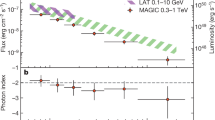Abstract
FOLLOWING the discovery of non-solar γ-ray bursts1, various models to account for their origin have been discussed. Extragalactic models include supernova bursts in remote galaxies2, and the collapse of the cores in active stars3, while galactic models are based on flare stars4, thermonuclear explosions on neutron stars5 and the sudden accretion of cometary gas on to neutron stars6. The acceptability of any of these models may be tested by the observed size spectrum of γ-ray bursts. The extragalactic models predict a power law spectrum with α = −1.5 while for the galactic models the number index will be −1. The experimental data on γ-ray bursts is still meagre. So far, about 44 confirmed events have been recorded by satellite-borne instruments7,8. The number spectrum of the observed γ-ray bursts (Fig. 1) shows that the observed distribution for events with an energy less than 10−4 erg cm−2 is flat and thus makes the choice of any model completely arbitrary. Carter et al.9 presented an upper limit on the number of γ-ray bursts having an energy > 2.10−7 erg cm−2 and suggested that the data are consistent with a power law spectrum in which α ∼ 0.5, or a modified galactic distribution. We present here an alternative analysis of the observed γ-ray events, which suggests very interesting possibilities for their origin.
This is a preview of subscription content, access via your institution
Access options
Subscribe to this journal
Receive 51 print issues and online access
$199.00 per year
only $3.90 per issue
Buy this article
- Purchase on Springer Link
- Instant access to full article PDF
Prices may be subject to local taxes which are calculated during checkout
Similar content being viewed by others
References
Klebesadel R. W. Strong I. B. & Olsen, R. A. Astrophys. J. Lett. 182, L85 (1973).
Colgate, S. A. Astrophys. J. 187, 333 (1974).
Prilutsky, O. F. & Usov, V. V. Astrophys. Space Sci. 34, 395 (1975).
Stecker, F. W. & Frost, K. J. Nature 245, 71 (1973).
Wooseley, S. E. & Taam, R. E. Nature 263, 101 (1976).
Harwit, M. & Salpeter, E. E. Astrophys. J. Lett. 186, L37 (1973).
Klebesadel, R. W. & Strong, I. B. Astrophys. Space Sci. 42, 3 (1976).
Cline, T. L. & Desai, U. D. Astrophys. Space Sci. 42, 17 (1976).
Carter, J. C., Dean, A. J., Manchanda, R. K. & Ramsden, D. Nature 262, 371 (1976).
Kodaria, K. Publ. Astr. Soc. Japan 26, 255 (1974).
Burton, W. B. Proc. Int. Symp. NASA, GSFC, June 2–4 (1976).
Lattimar, J. M. & Shramm, D. N. Astrophys. J. 192, L145 (1975).
Lattimar, J. M., Mackie, F. D., RavenHall, D. G. & Shramm, D. N. Bull. Am. Acad. Sci. 7, 546 (1975).
Strong, I. B. & Klebesadel, W. R. Sci. Am. 66, 1976.
Author information
Authors and Affiliations
Rights and permissions
About this article
Cite this article
MANCHANDA, R., RAMSDEN, D. The possible galactic origin of γ-ray bursts. Nature 266, 425–427 (1977). https://doi.org/10.1038/266425a0
Received:
Accepted:
Published:
Issue Date:
DOI: https://doi.org/10.1038/266425a0
Comments
By submitting a comment you agree to abide by our Terms and Community Guidelines. If you find something abusive or that does not comply with our terms or guidelines please flag it as inappropriate.



